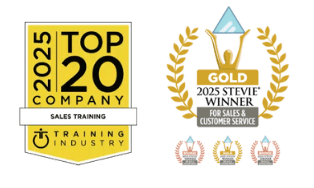
As sales managers, what are our most valuable assets? Our sales team, of course… but arguably even more important are our prospects and clients, without whom we have no business. Consider this: our existing clients represent a wonderful opportunity for us to really differentiate from our competitors. How? By recruiting them to sell for us, and thereby making life more difficult for our competition… through the art of reference selling.
Like most things… this requires a lot of hard work, personal investment in our relationships, attention to detail, and meticulous planning to get the best results from reference calls and client reference visits.
Experience has shown that planning, preparing, and executing client reference visits well makes a massive difference to the outcome of any major sales pursuit.
Moreover, if we find ourselves competing within the confines of a restrictive RFP process, the way we present our client references to our prospective clients can provide one of the few opportunities to really stand out.
Five key benefits of a well-executed client reference visit:
- Puts us into a better position of control.
- Differentiates our customer service and delivery.
- Instills confidence in our company.
- Increases our personal credibility with both prospects and existing clients.
- Creates new business opportunities.
Success, however, as is so often the case, lies in how well we prepare.
The importance of reference visits cannot be underestimated. Especially in these times where “virtual everything” seems to be the norm. We must be sure to allow enough time to plan and prepare thoroughly.
To be able to offer prospects relevant and persuasive references means we need to have personally invested in our client relationships over time. Have we taken the time to check in regularly to see how they feel about our customer service since we signed a deal with them? Have we taken actions in areas that could be improved? Do we invite them to relevant industry events either we (or other credible parties) are hosting? Do we share interesting publications? The bottom line is: do they feel we have a genuine interest in them and their business success beyond the sale?
What about when we signed the deal with them… did we sow the seeds for them to become references down the line? A really easy ask at contract signature time – but an opportunity so often missed.
If we have put in the effort, then hopefully when the time comes to ask for their help in hosting a prospect on a call or visit, they will be happy to help.
Having established our network of clients willing to speak on our behalf, reference planning should start very early in the sales process (once we are live into a sales pursuit). Then it should be assigned to and owned by a senior member of our team.
In essence, there are four key steps in the art of reference selling.
- Identify Appropriate Clients
Business to business, role to role – while it is helpful to align a client company to a prospect from a line of business perspective, this can sometimes prove challenging due to “competing business interests.”Often, a prospect will be interested to learn how peers in different industries have solved problems like those they also face. The key here is to align individuals with similar roles and responsibilities where possible – finance to finance, HR to HR, technical to technical, etc.
- Briefing Documents
For both our client and prospect, we should be setting out a short summary of the company’s business and markets, the purpose of the call / visit, who they will be visiting / speaking with, their title, and areas of responsibility for the relationship with our organization.Include the key areas of interest our prospect will want to cover and test that this is agreeable to both parties. The aim is to avoid any surprises.If you can have a call with your client ahead of the visit, discuss any specific asks you may have of them. For example, have them tell your prospect why they selected your company over XYZ company, etc.
If asked, are they going to praise the way in which your company has handled problems that have occurred since contract signature?
- Logistics
In these “Zoom days” it is relatively easy to make the calling arrangements, but once we are able to have prospects visiting clients again, then attention to detail is critical.What could go wrong? Do we have mitigation plans in place?For a physical visit, we should always be trying to accompany our prospects to and from our clients’ facilities, giving us valuable facetime and even more valuable feedback time after the visit.
- Follow Up
At the time of agreeing to logistics, it is important to ensure we have a date and time scheduled for follow up with both the client and prospect. For the client, (a) thank them for giving their time, and (b) listen to their account of how the visit went. For the prospect, find out how the experience was for them. Did they learn what they needed to? Do we need to arrange any further references?The truth is while a great reference visit may not assure success, we know for certain a poorly executed client reference call can lose a deal.So… let us plan for success, put in the hard work, and really leverage our most valuable assets: our clients using the art of reference selling!
Personal Challenge:
Early in the sales pursuit, decide which clients you want to engage as references. Plan your investment in them. Keep top of mind what you would want them to say about your company as a reference, which ties directly to delivering on what you promised.




